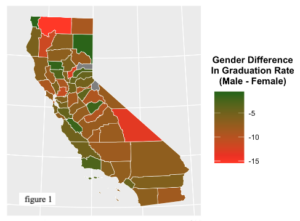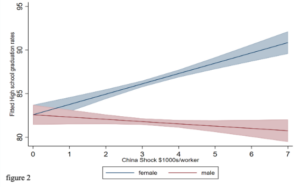
Article by Noah Hendelman
Recent research from economists like Richard Reeves has pointed to a concerning decline in men’s health and wellbeing. One of the most visible spheres displaying this trend is education, where male and female graduation rates have diverged at alarming rates. California is no exception to this phenomenon, as male students continue to fall behind their female counterparts. In 2018, more females graduated than males in every single county, as shown by the choropleth in figure 1.

Various hypotheses have been set forth attempting to explain this male regression in educational attainment. A lack of male educators, earlier female brain development, or favorable school structure prioritizing organization are reasons often cited. One area less explored is the rise of globalization, especially with regard to China.
Termed “the China Shock”, the flood of low-cost manufacturing exports from China following their 2001 admission to the WTO have been shown to have caused higher unemployment, lower labor force participation, and reduced wages in local U.S. labor markets with manufacturing industries.
We hypothesize that the loss of manufacturing jobs, which are traditionally male-dominated, may have adversely affected male role models and career trajectories, contributing to underperformance of teenage males. We test this hypothesis using measures from Autor, Dorn, and Hanson who quantified each commuting zone’s economic exposure to imports from China during the period from 2000-2007. A one-unit increase represents a $1000 loss per worker to the China Shock. We gathered California education data from schools in each county, separately recording the percentage of male and female students who graduated in the class of 2018, a decade after the China shock. By analyzing the correlation between China exposure and graduation rates a decade later, we test whether manufacturing job loss has driven education disparity between genders. Are the areas in California with greater exposure to Chinese exports more likely to have worse graduation rates, and how does exposure affect males and females’ graduation respectively?
Surprisingly, areas that were more exposed to Chinese imports at the beginning of the century have higher average graduation rates. However, there are strong gender differences: trade shocks drive male graduation rates slightly downwards but female graduation rates rise more steeply, making the overall relationship positive.

Figure 2 displays the predicted graduation rates of males and females at different levels of Chinese import exposure. When the trade shock is equivalent to or less than a loss of 1,000 dollars, the difference in graduation rates is not statistically significant, as reflected through the overlapping confidence intervals. The positive relationship between the China Shock and female graduation is both more statistically significant and far greater than the negative relationship between males.
While our findings do align with the original hypothesis that globalization drives gender gaps in graduation rates, we find it doubtful that exposure to Chinese imports has caused a rise in female graduation. The causal relationship underlying this correlation is likely to be more complex.
The influence of globalization on the various gender imbalances within the U.S. still remains in question. However, what does not remain in question is the necessity of acknowledging a male struggle in the U.S., especially in education. The underachievement of males in high-school graduation is hardly the only pertinent example. The gender difference in holding a bachelor's degree today favors women more than it favored men before title IX was instituted. In California, men are four times as likely to commit suicide than women, and 22 times as likely to end up in prison. Of the 142 U.S. mass shootings committed since 1982, 96 percent of them have been by men. The current movement towards gender equality for women in politics, family, and the workforce is long overdue and still has a long way to go. At the same time, many of the most pressing issues–from school shootings to far-right nationalism to the phobias of various identities–stem from boys feeling isolated and misunderstood. Addressing issues on both ends of the gender spectrum is of paramount importance in building a stronger future, and acknowledging that men are facing structural challenges is the first step.
